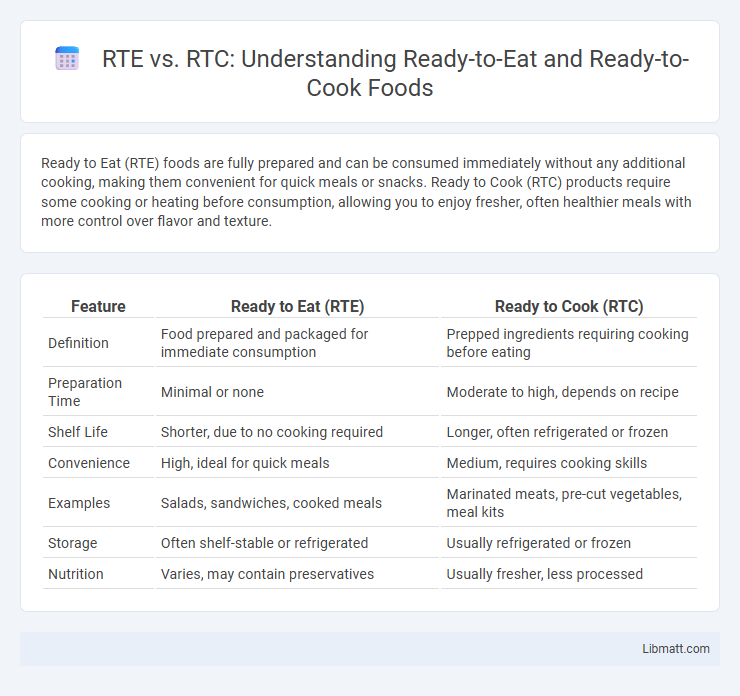Ready to Eat (RTE) foods are fully prepared and can be consumed immediately without any additional cooking, making them convenient for quick meals or snacks. Ready to Cook (RTC) products require some cooking or heating before consumption, allowing you to enjoy fresher, often healthier meals with more control over flavor and texture.
Table of Comparison
| Feature | Ready to Eat (RTE) | Ready to Cook (RTC) |
|---|---|---|
| Definition | Food prepared and packaged for immediate consumption | Prepped ingredients requiring cooking before eating |
| Preparation Time | Minimal or none | Moderate to high, depends on recipe |
| Shelf Life | Shorter, due to no cooking required | Longer, often refrigerated or frozen |
| Convenience | High, ideal for quick meals | Medium, requires cooking skills |
| Examples | Salads, sandwiches, cooked meals | Marinated meats, pre-cut vegetables, meal kits |
| Storage | Often shelf-stable or refrigerated | Usually refrigerated or frozen |
| Nutrition | Varies, may contain preservatives | Usually fresher, less processed |
Overview: Understanding RTE and RTC Foods
RTE (Ready to Eat) foods are fully prepared and can be consumed without further cooking, offering convenience and immediate consumption suitable for busy lifestyles. RTC (Ready to Cook) foods require additional preparation or cooking before eating, providing flexibility in meal customization and fresh cooking experiences. Understanding the distinction helps consumers make informed choices based on convenience, nutritional needs, and culinary preferences.
Definition: What Does Ready to Eat (RTE) Mean?
Ready to Eat (RTE) foods are pre-cooked or prepared products that require no further cooking or preparation before consumption, making them convenient for immediate use. These items are fully processed, packaged, and safe to eat directly, providing a quick meal solution without additional steps. Your choice of RTE products offers time-saving benefits, contrasting with Ready to Cook (RTC) foods that need cooking or preparation prior to eating.
Definition: What Does Ready to Cook (RTC) Mean?
Ready to Cook (RTC) refers to food products that are pre-prepared and require further cooking before consumption, offering convenience without compromising freshness. These products include marinated meats, cut vegetables, and partially processed ingredients that save preparation time while ensuring a cooked meal. RTC differs from Ready to Eat (RTE) foods, which are fully prepared and can be consumed immediately without additional cooking.
Key Differences Between RTE and RTC Foods
RTE (Ready to Eat) foods require no further preparation or cooking before consumption, making them ideal for quick meals, while RTC (Ready to Cook) foods need to be cooked or reheated before they are safe to eat. RTE products prioritize convenience and immediate consumption, often featuring items like salads, sandwiches, and pre-cooked meals, whereas RTC foods include raw or partially prepared ingredients such as marinated meats or chopped vegetables. Understanding these key differences helps you choose between immediate eating and cooking flexibility based on your meal preparation preferences and time constraints.
Benefits of Ready to Eat (RTE) Food Options
Ready to Eat (RTE) food options offer unparalleled convenience by eliminating the need for preparation and cooking, saving significant time for busy lifestyles. These foods ensure consistent quality and safety through rigorous processing standards, which reduces the risk of contamination compared to Ready to Cook (RTC) products. Choosing RTE meals allows you to enjoy a variety of nutritious options quickly, supporting balanced eating habits without the hassle of meal planning or extended cooking times.
Advantages of Ready to Cook (RTC) Food Products
Ready to Cook (RTC) food products offer superior freshness and nutritional retention compared to Ready to Eat (RTE) meals, as they preserve natural flavors and essential vitamins through minimal processing. RTC options provide greater culinary flexibility, allowing you to customize seasoning and cooking methods to your preference, ensuring a more personalized dining experience. Storage and transportation benefits include longer shelf life under refrigeration, reducing food waste and enabling easier inventory management.
Shelf Life and Storage: RTE vs RTC
RTE (Ready to Eat) foods typically have a shorter shelf life than RTC (Ready to Cook) products due to their fully prepared nature and higher moisture content, requiring refrigeration or freezing to maintain freshness. RTC items, often less perishable and stored in raw or minimally processed form, can last longer under proper storage conditions such as cool, dry environments or freezing. Your choice between RTE and RTC should consider storage capacity and desired convenience, as RTE demands faster consumption while RTC offers extended flexibility.
Safety and Health Considerations
Ready to Eat (RTE) foods eliminate the risk of improper cooking as they require no further preparation, reducing the potential for foodborne illnesses compared to Ready to Cook (RTC) products that must be thoroughly cooked to achieve safety. RTE items undergo stringent safety protocols including pasteurization or irradiation to ensure pathogens are eradicated, while RTC foods depend heavily on consumer adherence to cooking instructions to prevent contamination. Health considerations emphasize that RTE foods often contain preservatives to maintain shelf-life, whereas RTC foods offer fresher ingredients but carry risks if mishandled or undercooked, affecting overall food safety and nutritional quality.
Consumer Trends and Market Growth
The Ready to Eat (RTE) market experiences rapid growth driven by rising consumer demand for convenience, busy lifestyles, and on-the-go consumption patterns. Ready to Cook (RTC) products attract health-conscious consumers seeking fresh ingredients with minimal preparation time, fueling steady market expansion in urban areas. Both segments capitalize on technological advancements in preservation and packaging, enhancing shelf life and quality, which further boosts consumer acceptance and market penetration.
Choosing the Right Option: RTE or RTC?
Choosing between Ready to Eat (RTE) and Ready to Cook (RTC) depends on convenience, preparation time, and dietary preferences. RTE foods provide immediate consumption with minimal preparation, ideal for busy lifestyles or on-the-go meals, while RTC products require cooking, allowing greater customization and fresher taste. Assessing factors like cooking facilities, nutritional control, and flavor preferences helps determine whether RTE or RTC best suits individual needs.
RTE vs RTC (Ready to Eat vs Ready to Cook) Infographic

 libmatt.com
libmatt.com